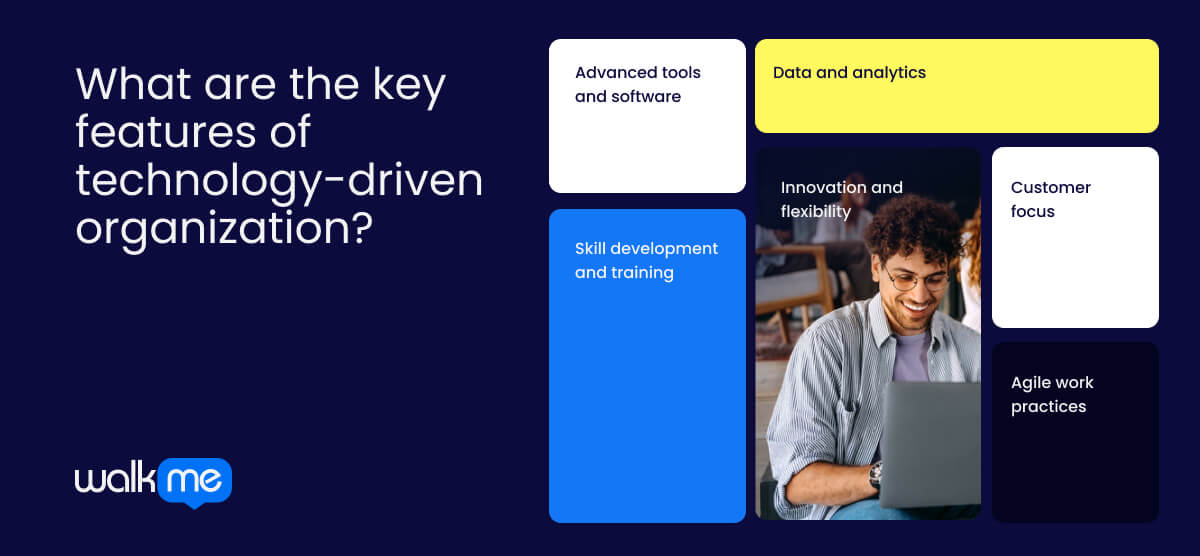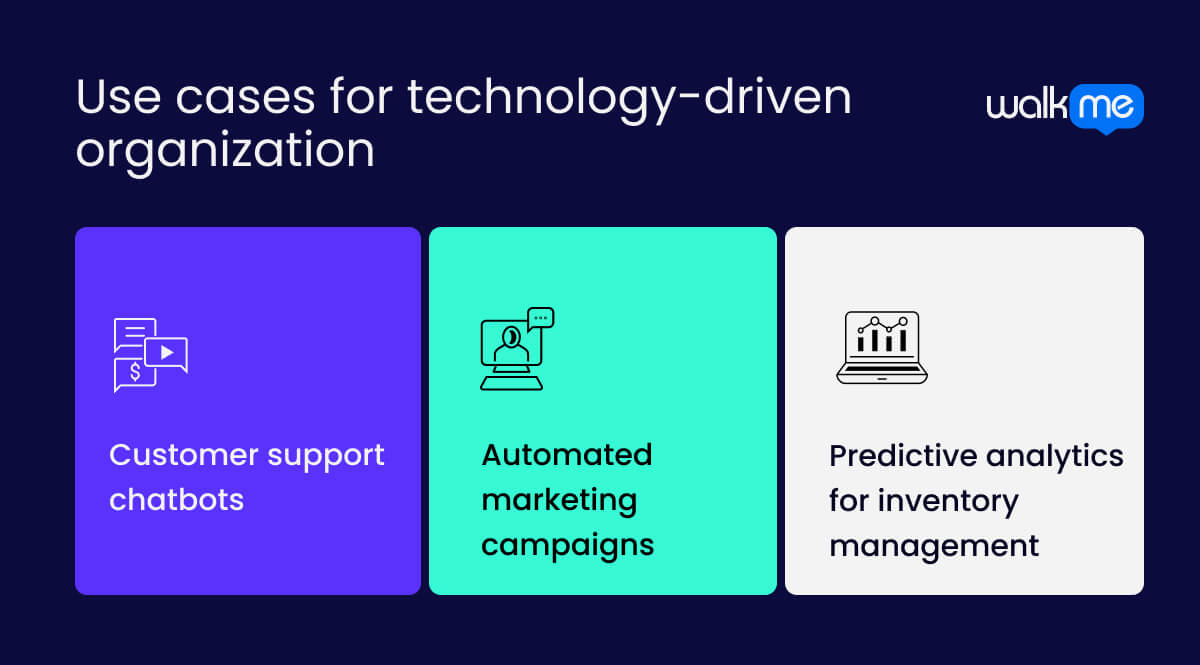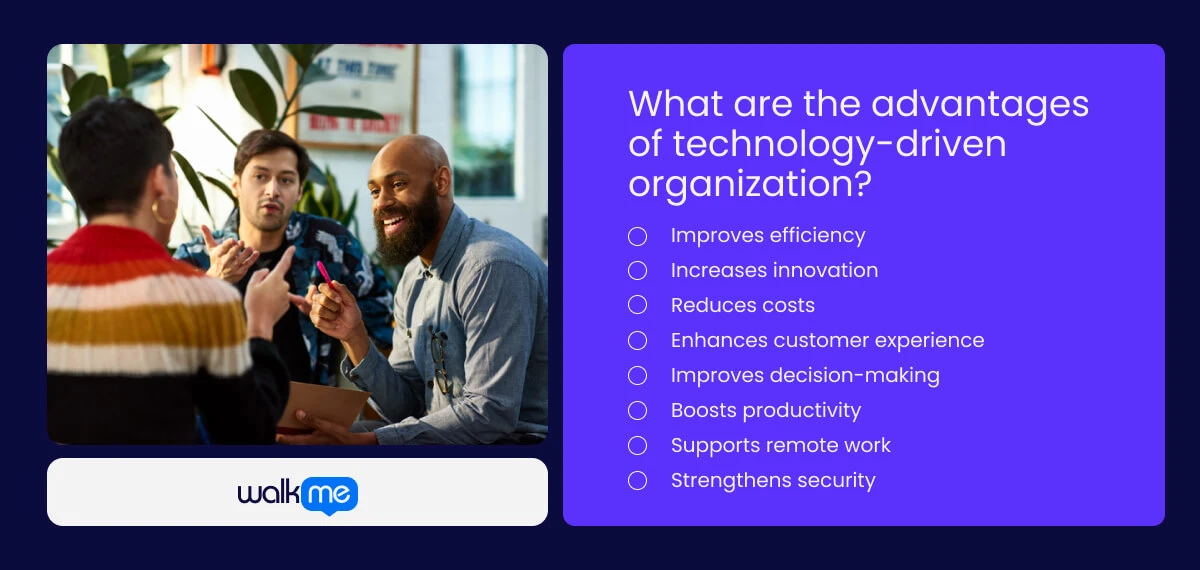Table of contents
- What is a technology-driven organization?
- What are the key features of technology-driven organization?
- Technology-driven organization vs. technology-enabled organization
- Use cases for technology-driven organization
- What are the advantages of technology-driven organization?
- What are the challenges of technology-driven organization?
- How can DAPs help with technology-driven organization?
These companies often focus on creating or using advanced tools that keep them ahead in their field. Many of them might build their own software, use powerful computers, or try out new gadgets to do their jobs better.
Technology-driven organizations also focus on using technology to solve problems. When they find a better way to do something, like speed up production or improve customer service, they will often try it. New solutions that help the business, employees, and customers are highly valued, and the organizations are open to change and learning.
In a technology-driven company, employees might work with many different tools or programs every day. Staying updated on the latest technology is also encouraged so everyone keeps learning.
What are the key features of technology-driven organization?

A technology-driven organization has several key features that help it stay competitive and grow.
These features include using advanced tools and software, focusing on data, and being flexible to changes in the business world.
Employees are encouraged to keep learning, and the organization works hard to meet customer needs. Teams also follow work methods that allow them to quickly adapt to new situations and changes.
Let’s take a closer look at the key features that make technology-driven organizations successful:
Advanced tools and software
Technology-driven companies use the latest tools and software to make their work easier and faster. They might rely on smart machines, custom software, or special tools to complete tasks more efficiently. These tools help the company get more done in less time, which helps it stay ahead of competitors.
Data and analytics
Companies in this type of organization focus on gathering and using data to make better decisions. By analyzing data, they can spot patterns, fix problems, and find the best ways to improve the business. They can make smarter choices that lead to growth and success.
Innovation and flexibility
Being open to new ideas is key for these organizations. They are always looking for ways to improve by testing new tools or trying out different approaches. They are willing to change how they work if it will help them grow or do things more efficiently.
Skill development and training
In technology-driven organizations, employees are encouraged to keep learning and improving their skills. These companies offer regular training to help employees stay up to date with new tools, technology, and best practices. Employees become more effective and it helps the company stay competitive.
Customer focus
Many technology-driven companies use technology to better serve their customers. For example, they might use tools that make it easy for customers to contact them or even predict what they might need in the future. Focusing on customers builds stronger relationships and keeps people loyal to the brand.
Agile work practices
These companies often work in small teams that can adjust quickly to market changes. This way of working is called being “agile.” It helps the company respond quickly to new trends, test new ideas, and make changes without long delays. Being agile allows businesses to stay ahead and be flexible in a fast-changing world.
Technology-driven organization vs. technology-enabled organization
Technology-driven and technology-enabled organizations both use technology, but they do so in different ways.
- A technology-driven organization relies heavily on tech to drive its growth and operations
- A technology-enabled organization uses tech to improve existing processes
Let’s explore the differences between these two types of companies.
| Technology-driven organization | Technology-enabled organization | |
| Definition | Puts technology at the center of everything it does. Technology helps the business grow and improve. | Uses technology to help with its work but does not rely on it as its main focus. Technology just makes tasks a bit easier. |
| Focus | Use new technology to grow and get ahead. Technology helps the business be different and better than others. | Using technology to improve tasks that are already in place, without changing the core of the business. |
| Techniques | Advanced tools like data analysis, AI, and automation. They look for new ways to do things with technology. | Simpler tools, like regular software or communication apps, that help with daily work but don’t change how they do business. |
| Goals | Be a leader in using technology, creating unique solutions, and standing out. | Work better and faster, using technology as a helpful tool, not a game-changer. |
| Examples of use | A company that uses AI to guess what customers want or uses custom tools in every part of its work. | A business that uses basic office software or a customer database to help with tasks but still works in the usual way. |
Use cases for technology-driven organization

Technology-driven organizations use technology in many ways to help their business grow. Whether it’s speeding up customer support or improving marketing, technology helps these companies stay on top.
For example, technology strengthens supply chain management and boosts competitiveness. By using tools like track-and-trace and big data analytics, companies can reduce risks, avoid disruptions, and gain an advantage.
It might be hard to see how technology-driven organizations work in practice, so here are three examples.
Customer support chatbots
Customer support chatbots help companies answer questions quickly. The robot uses smart technology to understand what people ask and give answers.
It can fix simple problems and tell customers who to talk to for harder problems. Chatbots help businesses answer many questions quickly without needing a person every time.
The customer service team can work on tricky problems while the chatbot helps with easy ones, improving operations.
Automated marketing campaigns
Automated marketing campaigns send messages to customers when they do something, like buy a product or click on a link. The system watches what they do and sends the right message.
It sends messages at the best time without anyone having to do it. This helps businesses talk to customers and tell them about new updates or deals.
By doing this automatically, businesses save time and get more people interested in what they’re selling.
Predictive analytics for inventory management
Predictive analytics helps businesses guess what products they will need. It looks at what has sold before and other factors to make a data-driven guess.
It helps businesses keep the right amount of things in stock, so they don’t run out or have too much.
This way, businesses can make smart choices, waste less, and make sure they have enough for customers without too many extra items.
What are the advantages of technology-driven organization?

A technology-driven organization brings many benefits to businesses. By using the right tools and systems, companies can make their work faster and easier. As a result, they can make better decisions, improve how they serve customers, and save money.
Let’s look at all the ways technology can help businesses.
Improves efficiency
Technology helps businesses do tasks faster and with fewer mistakes. Tools like automation and artificial intelligence (AI) can handle tasks quickly, so workers don’t have to do them by hand. When tasks are done faster, workers have more time for other important jobs. Over time, this helps the company grow and be more successful.
Increases innovation
New technology helps businesses develop new ideas, products, and ways of working. By using the latest tools, companies can find better ways to meet their customer’s needs and offer something special that helps them stand out from their competitors.
Reduces costs
Technology can help businesses save money by doing jobs that used to need people. For example, automation can take care of tasks that are the same every time, so fewer workers are needed. Companies can spend less on workers and use the money saved for other things to help the business grow.
Enhances customer experience
Technology, like chatbots and emails made just for each customer, helps businesses provide better service. Customers can get answers quickly, and messages can be sent that are right for them. They feel important, and it helps them keep coming back for a good customer experience.
Improves decision-making
With technology, businesses can gather and look at lots of information quickly. It helps them make better choices that can help them grow. For example, they can see which products customers like best or what changes they need to make to do better.
Boosts productivity
Technology helps workers get more done. Automation can take care of repetitive tasks, and software helps workers work better together. Employees can focus on more important work, leading to better company results.
Supports remote work
Thanks to technology, workers can do their jobs from anywhere. Tools like video calls and shared documents make it easy to work together, even if people are in different places. Therefore, companies can hire workers from anywhere and let employees have a better work-life balance.
Strengthens security
Technology helps protect a company’s important data and information. Strong security tools can stop attacks and keep information safe, which is important to maintain customer trust and protect the company’s reputation.
What are the challenges of technology-driven organization?
Now let’s explore the challenges of being a technology-driven organization.
While technology helps businesses grow and improve, it also brings its own set of difficulties. From high costs to security risks, several factors must be considered when relying heavily on technology.
Let’s take a closer look at some of these challenges.
High costs
Using advanced technology can be expensive. Buying new tools, software, and equipment often requires a lot of money. On top of that, there are costs for training employees and maintaining the technology. Small businesses might find it hard to afford these expenses.
Learning curve
Employees may need to learn how to use new tools and systems, which can take time and be difficult, especially if the technology is complex. Companies may need to provide extra training to help their workers get up to speed.
Tech problems
With so much technology, problems can happen. The software might not work as expected, or the system could crash. This can slow down work and lead to frustration. Companies have to make sure they have the right support in place to fix issues quickly.
Security risks
Using more technology means there’s more data to protect. If systems aren’t secure, important business information or customer data could be stolen or lost. Organizations need to invest in strong security measures to keep everything safe.
How can DAPs help with technology-driven organization?
Digital adoption platforms (DAPs) are helpful tools for companies that use a lot of technology. They help businesses learn how to use new tools and systems more easily.
Let’s look at how this software can help companies run better and stay ahead with the right tech.
Guided learning
Workers get help step by step to learn how to use new tools. The system shows them simple instructions and tips that are easy to follow. Learning becomes quicker and less confusing, so people can start using the new tools quickly. If they need help, the system is always there to guide them, making it easier to understand.
Error prevention
The system can help stop mistakes before they happen. If a worker is about to make a mistake, the system will warn them or suggest a better way to do things. Such a process helps to avoid errors that could slow people down or cause problems. With these helpful reminders, workers can feel sure about what they are doing and get things done correctly.
Streamlined processes
When workers get clear instructions, tasks are easier to do. Instead of figuring out tricky steps, the system tells them exactly what is needed. Repetitive jobs can be done automatically, so workers don’t have to do them over and over. Work becomes faster, and it helps everyone get more done in less time.
Continuous learning
Learning doesn’t stop after the first lesson. Workers keep getting new tips and updates to learn about new tools or changes. They stay smart and ready for new challenges. With ongoing lessons, workers can always get better at using the tools and stay up to date.
Last Updated:
